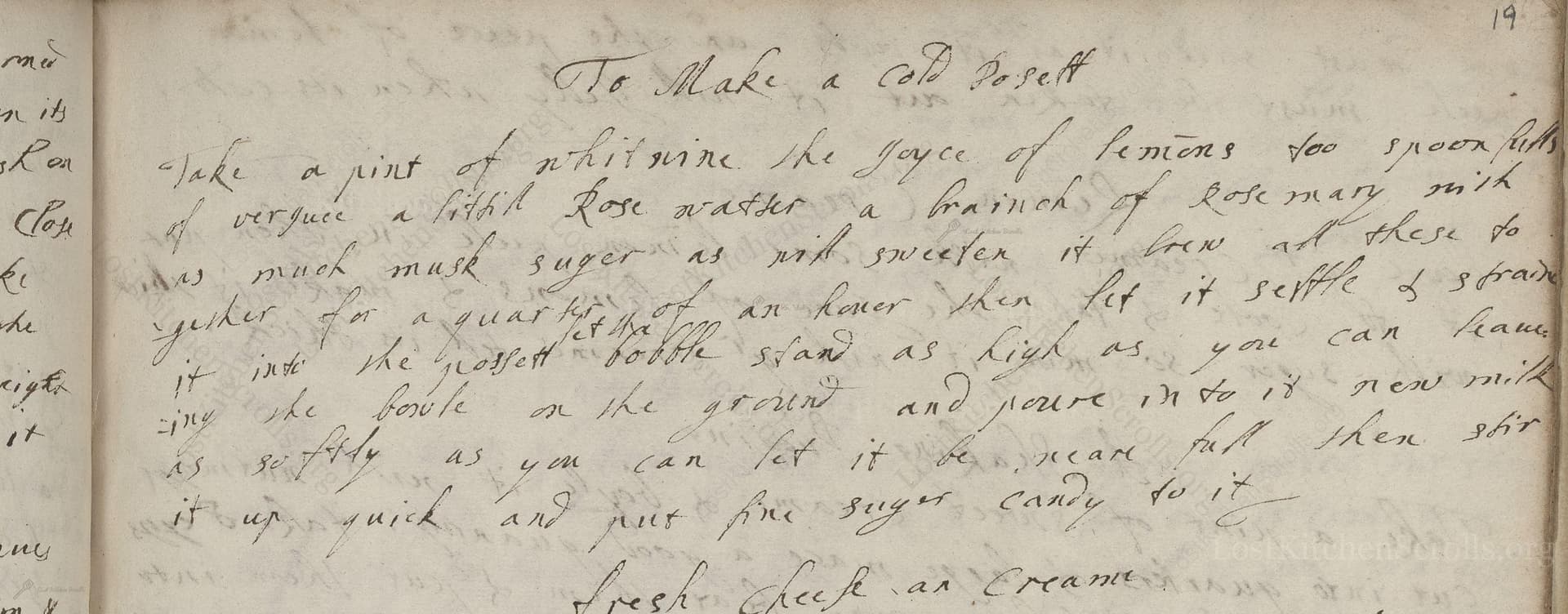To Make A Cold Posett
From the treasured pages of Receipts in cookery and medicine 1700
Unknown Author

To Make A Cold Posett
"Take a pint of whitwine the joyce of lemons too spoonfulls of verjuice a litle Rose water too branchs of Rosemary milk as much musk suger as will sweeten it brew all these to gether for a quarter of an hower then let it settle & straine it into the possett boble stand as high as you can leave the bowle on the ground and poure into it new milk as sofly as you can let it seeth up quick and put fine suger candy to it"
Note on the Original Text
The language of the original recipe is brief and commands familiarity with both basic cookery and specialized ingredients. Spelling and capitalization are fluid ('hower' instead of 'hour', 'joyce' for 'juice', 'bowle' for 'bowl'), which was normal for handwritten receipts of the time. There is little concern for precise quantities—'as much as will sweeten'—reflecting both the oral traditions of cookery and the expectation of a knowledgeable cook able to adjust flavors by eye and taste. Directions are sequential but informal, weaving together action and equipment in a single breath.

Title
Receipts in cookery and medicine 1700 (1700)
You can also click the book image above to peruse the original tome
Writer
Unknown
Era
1700
Publisher
Unknown
Background
Step into the kitchen of the early 18th century, where this charming culinary manuscript tempts tastebuds with recipes and secrets from a bygone era. A delicious journey for both the curious cook and the history lover.
Kindly made available by
Folger Shakespeare Library
This recipe for a 'cold posset' comes from around 1700, a period when possets had begun to evolve from earlier hot, spiced drinks thickened with eggs or cream, towards more delicate, curdled dessert drinks enjoyed by the gentry. Possets were often associated with celebrations and were thought to have medicinal properties. The inclusion of exotic ingredients like musk (here substituted) and rosewater signals the wealth and sophistication of the recipe’s owners. The original manuscript 'V.b.273' is representative of early 18th-century English household receipts, where cooks and housekeepers recorded their most prized formulations both for daily use and special occasions.

Historically, this posset would have been made using a brass or copper saucepan over the hearth fire, with wooden spoons and strainers for mixing and separating the solids. Lemon juice would be extracted using a citrus press or by hand. The mixture would be poured through a fine cloth or sieve (possibly into a special posset pot) to remove the rosemary and any curds forming a 'posset boble'. Old-fashioned posset bowls, typically two-handled and decorative, were used for serving—sometimes with the mixture poured dramatically from a height to create a frothy head.
Prep Time
10 mins
Cook Time
20 mins
Servings
4
We've done our best to adapt this historical recipe for modern kitchens, but some details may still need refinement. We warmly welcome feedback from fellow cooks and culinary historians — your insights support the entire community!
Ingredients
- 2 cups (about 16 fl oz) dry white wine
- Juice of 2 lemons
- 2 tablespoons (1 fl oz) verjuice (or 2 tbsp lemon juice as substitute)
- 1 tablespoon rosewater
- 2 sprigs fresh rosemary
- Superfine sugar, to taste (approx. 2–3 tbsp)
- Pinch ground nutmeg (modern substitute for musk)
- 1 cup (8 fl oz) whole milk
- 1 tbsp sugar candy (rock sugar or caster sugar)
Instructions
- Begin by pouring 2 cups (about 16 fl oz) of dry white wine into a saucepan.
- Add the juice of 2 lemons, 2 tablespoons (1 fl oz) of verjuice (or substitute with 2 tablespoons more lemon juice if verjuice is unavailable), and 1 tablespoon of rosewater.
- Drop in two sprigs of fresh rosemary.
- Sweeten the mixture to taste with superfine sugar (about 2–3 tablespoons), and add a pinch of ground nutmeg (the closest modern substitute for musk, which is not used in cooking today).
- Gently heat the mixture, letting it brew together over low heat for about 15 minutes, without allowing it to boil.
- Stir occasionally.
- Once infused, remove the rosemary and strain the mixture into your serving vessel.
- Separately, in a small saucepan, heat 1 cup (8 fl oz) of fresh, whole milk until nearly boiling.
- While holding your infusion high above the vessel, pour the hot milk in a thin stream into the wine mixture, letting it froth and 'seethe up' quickly.
- Finish by sprinkling over a tablespoon of finely crushed sugar candy (rock sugar or caster sugar) and serve immediately for a lightly curdled, frothy posset.
Estimated Calories
210 per serving
Cooking Estimates
This posset recipe takes about 10 minutes to prepare and 20 minutes to cook. Each serving contains about 210 calories, and the recipe makes 4 servings.
As noted above, we have made our best effort to translate and adapt this historical recipe for modern kitchens, taking into account ingredients nowadays, cooking techniques, measurements, and so on. However, historical recipes often contain assumptions that require interpretation.
We'd love for anyone to help improve these adaptations. Community contributions are highly welcome. If you have suggestions, corrections, or cooking tips based on your experience with this recipe, please share them below.
Join the Discussion
Rate This Recipe
Dietary Preference

Den Bockfisch In Einer Fleisch Suppen Zu Kochen
This recipe hails from a German manuscript cookbook compiled in 1696, a time whe...

Die Grieß Nudlen Zumachen
This recipe comes from a rather mysterious manuscript cookbook, penned anonymous...

Ein Boudain
This recipe comes from an anonymous German-language manuscript cookbook from 169...

Ein Gesaltzen Citroni
This recipe, dating from 1696, comes from an extensive anonymous German cookbook...
Browse our complete collection of time-honored recipes



